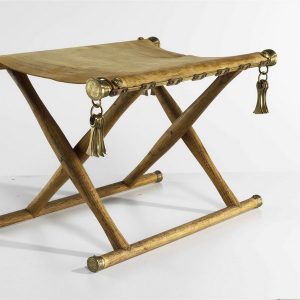What would life have been like way back in the Stone Age? It was so long ago that little evidence remains except at Skara Brae. Want to know more about the Neolithic life and see what the houses and furniture in the ancient life on the British Isles? Click here. We’ve mentioned that Skara Brae is famous for its incredible preservation, but how great is it? Visitors to the archaeology site today can actually sit in the furniture used by the original inhabitants! How is this possible? Well, it’s not just because the sands covered and preserved the site. It’s because every piece of furniture in Skara Brae is made of stone. In this part of Scotland, wood is extremely scarce. So, the inhabitants of Skara Brae had to make do with what they had, and what they had was stone. In this article, we are going to find out more about ancient furniture that has been excavated from the 8th-century, the Midas Mound, in Gordion, Turkey. Pieces found here include tables and serving stands.
Ancient Egypt
The ancient Egyptians formed the first of the great classical civilizations. While most of Europe was still in the Stone Age, the Egyptians were building palaces, studying mathematics, and writing on papyrus. They were great builders and great artists, drawing the inspiration for their art from nature. A complex social and religious structure was in place. The Egyptians kept books of accounts and recorded history; their children played with carved wooden toys with moving parts.
Egypt was eventually conquered by Alexander the Great, and later by the Romans. Both the Greek and Roman conquerors were significantly influenced by Egyptian culture, art, and philosophy so that to some extent it was a case of the conquerors being civilized by the conquered. Civilization in ancient Egypt began with the clearance and irrigation of land along the banks of the River Nile, which began in about 6000 BCE. By that time, society in the Nile Valley was already engaged in organized agriculture and the construction of large buildings. At this period, Egyptians in the southwestern corner of Egypt were herding cattle and also constructing large buildings.
The Furniture of Ancient Egypt
The ancient Egyptians had sophisticated furniture for their time period; tomb paintings show Egyptians using chairs, tables, couches, chests, stools, and beds. In fact, some well-preserved pieces of ancient Egyptian furniture have been recovered from tombs of Egyptian queens, Pharaohs, and other wealthy ancient Egyptians, and can be seen today in museums. There was a big difference between the furniture of peasants and the wealthy and it is largely due to the burial rituals of the wealthy that pieces of furniture from ancient Egypt have been preserved and can be seen today.
Most ordinary Egyptians did not have a lot of furniture; the pieces they did have were very simple, and they made the pieces themselves. The most common piece of furniture was a three or four-legged low stool covered by leather or wool. The cheapest stools had frames made of reeds and had seats made of woven rushes like the wicker furniture of today. Stools with three flared legs and a shaped wooden seat were commonly used by artisans. Most of the people in the lower classes had chests and baskets to hold their few belongings. Wood was expensive, so the chests were often made of reeds. Tables were not common, not even among the wealthier scribes-they usually squatted on the floor and used a wooden board to write on. Even meal preparation was done on the floor. People sat on the ground on reed mats, pillows, or on low stools.
Stools
Common Egyptians slept on mattresses of wool, straw, reed mats, or the floor. In contrast, the nobility and royalty of ancient Egypt had much more furniture, and the pieces were of much higher quality and made by artisans. Four-legged wooden stools were used by the wealthy as well as the poor, but the stools of the wealthy were much nicer. Stools of the wealthy often had seats made from animal skins, woven leather strips, or plant materials. Some were painted and featured carved animal legs. Ancient Egyptians also used folding stools; one of the most stunning examples of a folding stool is the one found in Tutankhamun’s tomb. There are two sets of legs in x shapes that fold. The legs and seat are made of wood and painted in black and white to imitate animal skin.
Chairs
Chairs were used only by the wealthiest people in ancient Egypt. The higher the status of the individual, the taller and fancier the chair the person sat on was. The rich had chairs painted to look like the carved and inlaid chairs of the queens and pharaohs, but these were cheaply made replicas in comparison. Chairs were usually made of wood and were much like today’s chairs except that often they were much lower to the ground. A very elaborate chair from King Tutankhamun’s tomb has a scene carved into the back, a bucket seat, lion legs ending in lion paws, and a gold inlay of eagle’s wings. Chairs featuring scenes, inlays, heads, animals, carving, and precious materials such as gold and ivory were common among the ruling families.
Tables
Tables, another very common furniture piece in the Egyptian home, were often made of wood and stone and sat quite low to the ground. Therefore, the ancient Egyptians must have stooped down at them for meals, game playing or writing, or other activities. Most of the tables were small and portable and made for individual use. According to Sibal, there were other types of tables: There was the offering table that held food the ancient Egyptians symbolically gave to their deceased. The people also used displayed vases and other ceramics on these small tables. The large permanent dining table that seated several people are only a couple of centuries-old in Egypt.
Chests, Boxes, and Cabinets
Finally, no ancient Egyptian home was complete without numerous chests, boxes and cabinets. They date from Predynastic times and were made of wood, reed, or rush. The Egyptians used them for all sorts of reasons to store linen and clothing; hold jewelry, cosmetics, and mirrors, and house items that would be taken into the afterlife. Chest and box designs ranged from the simple to the complex, such as those chests covered with ornate inlays. By the Middle Kingdom, Egyptian craftsmen were making compartmentalized boxes with sliding lids and drawers. This eventually led to the development of cabinets with hinged doors.
The Egyptians were experts, as we well know from museum pieces, in marquetry decorating furniture with inlays of wood or ivory. As with all societies, the type and style of furniture were dictated by the wealth of the owner. Ancient Egyptian furniture was made by skilled carpenters in their workshops but poorer people made their own furniture. The items of furniture which could be found in an Ancient Egyptian home would include stools, beds, lamp stands, chests, and shrines. Only the very wealthy or royalty possessed chairs.
Material
The woods commonly used for Egyptian furniture were cedar, cypress, and ebony. Gold, silver, and ivory inlays were used for decorations. Furniture pieces used for religious or state ceremonies were often ornamented with precious stones and brilliant enamels. In Kaliuda Gallery, you can custom various furniture & home decorations. Located in Bali. We are one of the best Bali furniture stores and antique galleries with the best quality and service. Keep ready our blog to find out more about ancient Greece and ancient Rome’s history of furniture.





